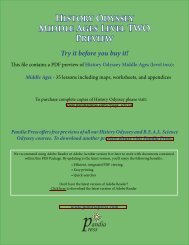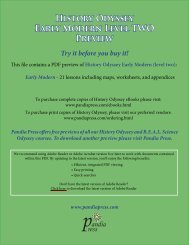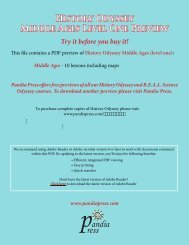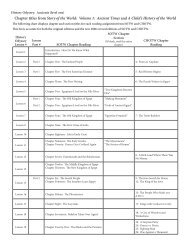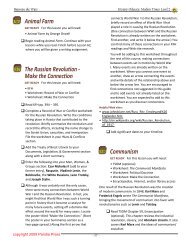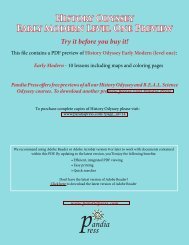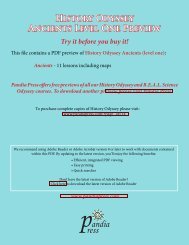History Odyssey: Middle Ages (level three) eBook ... - Pandia Press
History Odyssey: Middle Ages (level three) eBook ... - Pandia Press
History Odyssey: Middle Ages (level three) eBook ... - Pandia Press
- No tags were found...
Create successful ePaper yourself
Turn your PDF publications into a flip-book with our unique Google optimized e-Paper software.
If you do not already have a process in place for teaching your student essay writing, we recommend thefollowing writing programs:Brave Writer “Help for High School” e-book www.bravewriter.com/Welcome/hhsdescrip.htmlTeaching Writing Structure and Style by The Institute for Excellence in Writing www.writing-edu.comWriting Strands www.writingstrands.comTeaching the Essay and Teaching the Research Paper by Robin Finley www.analyticalgrammar.comOther writing resources can be found online by doing a search with the words “high school writing” and“thesis statement history” and following the links offered. Pay particular attention to thesis statements, developingarguments, and typical essay forms. Review formats for attribution of quotes and have students take great carein citing sources to avoid plagiarism in their academic writing.You will find an Essay Grading Rubric in Appendix H. Copy and use this page for evaluating or grading theessay writing assignments.TimelinesChoose a timeline format that suits your needs. Timelines can be notated in many different ways includingwriting dates and descriptions only, drawing illustrations to accompany your dates and descriptions, or purchasingtimeline software. Periodically throughout this course, you will be revisiting dates on your timeline to addinformation about additional cultures and events.Alternatively, you may opt to omit a timeline from your rhetoric stage study. This may be appropriate if youhave a solid foundation in timeline construction and analysis. We strongly recommend you keep a timeline ifyou have no prior experience with this tool.The Timeline Analysis assignment in Part XV is recommended for all students.Map WorkGeography is a key element in the study of history. We recommend you color your maps using good qualitycolored pencils and label them with a fine-point pen.When you have completed each map as assigned, we suggest you create a transparency overlay for that mapon which you will label modern-day countries and cities. This will give you a firm understanding of the changesthat have occurred over time and of the historical areas of the world as they correspond to today’s regions. Youcan accomplish this by using write-on transparency film (available at office supply stores) and markers designedfor transparency use. Just trace the outlines from your completed map and fill in the current information usinga world atlas, wall map, or globe. Another option is to use printer/copier transparency film and copy each maponto the transparency before completing the assignment. Then you can fill in the modern information on thecopied transparency. As a final option, you may write the modern-day labels in parentheses on each map.We have included a few Web addresses, especially for map resources, in this guide. In the event that youdo not have Internet access, you should be able to locate your resources at a library. Many of the map workassignments can be completed using the historic maps found in World <strong>History</strong> Atlas from Maps.com. You willfind many Web links to Maps.com in this guide. Alternatively, you might consider purchasing the print editionof World <strong>History</strong> Atlas.9



